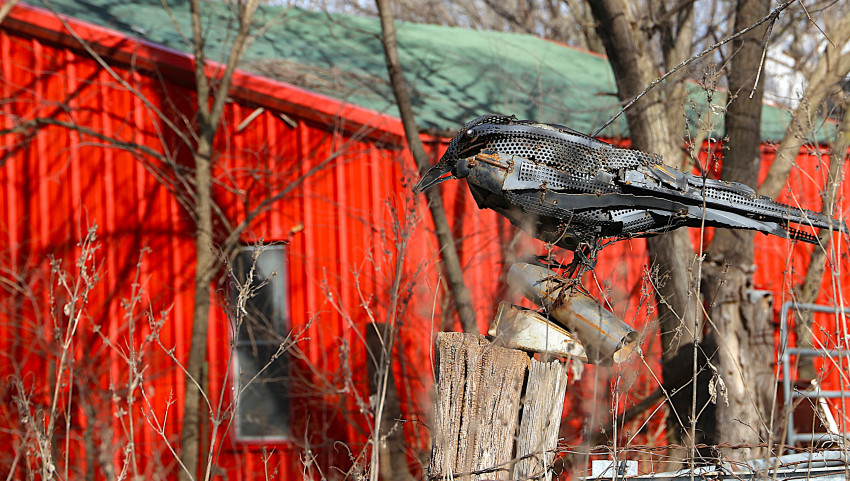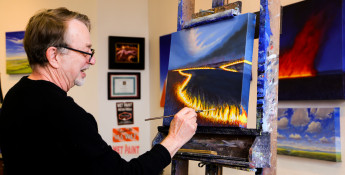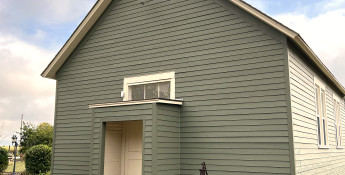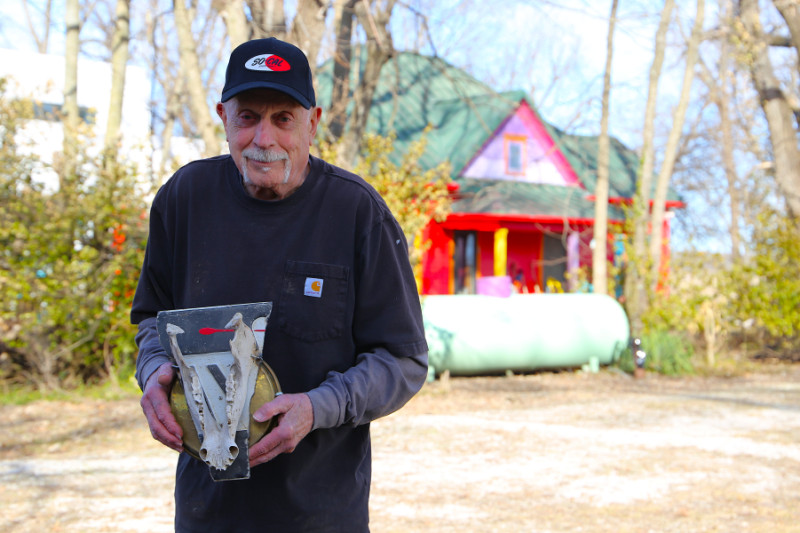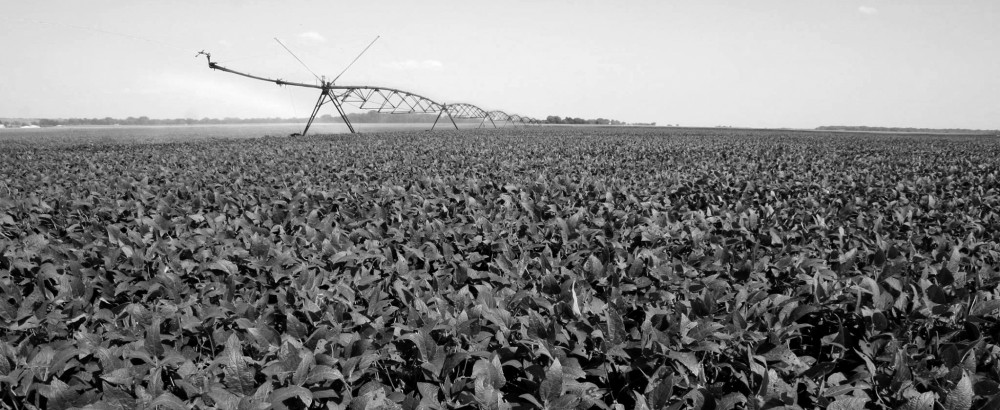By Greg Doering on March 31, 2025
From Scrap to Sculpture: The Artistic Vision of Miami County’s Guinotte Wise
Sculptor, writer and explorer Guinotte Wise turns found objects, experience into creative expression

Guinotte Wise doesn’t stroll by the junk piled around his rural homestead in Miami County. Rather he scans the heaps of metal and waits for a road sign to catch his eye. Or a scrap of angle iron. Or a car grille. The source material is endless, but the inspiration is only occasional.
When it does strike, it can take just a few hours for Wise to assemble a mixture of elements into abstract artwork, but the octogenarian also uses everyday items to make representational metal sculptures of horses, birds and motorcycles. Wise’s artwork comes from a series of small gambles.
“If you use the right found objects, you win,” he says. “If you don’t, back to the scrap pile it goes.”
In explaining his style, Wise says he shares the vernacular of French painter and sculptor Marcel DuChamp, whose work includes readymade art defined as the use of ordinary objects promoted to the dignity of art simply by the artist’s choice.
Wise is careful to explain that “sharing a vernacular with a great artist doesn’t mean sharing his impact.”
WISE ACRES
Wise lives in the unincorporated community of New Lancaster in Miami County. Despite the proximity to the ever-expanding metro to its north, Wise’s homestead feels remote even though you can see nearby rooftops from the yard.
He and his wife, Freddie, live in a multi-colored century-old farmhouse, which also fits the artistic couple. “She’s a very talented silversmith,” he says of Freddie. “She has made some stunning items – bracelets, pendants, wedding rings, all kinds of things.”
The couple have two Australian shepherds, Cash and Millie. “Best I’ve ever had,” Wise says, then pauses and reconsiders. “Well, I won’t say that because I’ve loved them all.”
In the 30 years on the property, they’ve owned several horses and have nurtured a variety of wildlife, in addition to Wise’s sculptures that dot the property alongside the junk piles and outbuildings.
Wise’s office occupies the loft of a modern addition. A midcentury modern desk is free from clutter, but it’s not sterile. There are bookshelves, photos and a calendar stuck on September 2014 with a photo of a typewriter.
“It’s an Adler Contessa,” Wise says. “I owned one once and would like to again. I like the noise of the keys and the return and all that typewriter business that goes on in that machine.”
CHILD’S PLAY
In many ways, Wise’s work and living arrangement reflects a childhood of boredom and wandering where creative endeavors were as much about entertainment as they were expression. He recalls drawing scenes of stampeding horses across the backs of wallpaper rolls or using a rubber type printing press to produce yellow journalism of people in his neighborhood.
“My stepfather worked on the Manhattan Project so I rarely saw him,” Wise says of his formative years during World War II. “Rarely saw my mother, and I was dumped at my step grandparents’ home in Louisiana.”
It was a rural area with lots of open land where Wise had total freedom to roam.
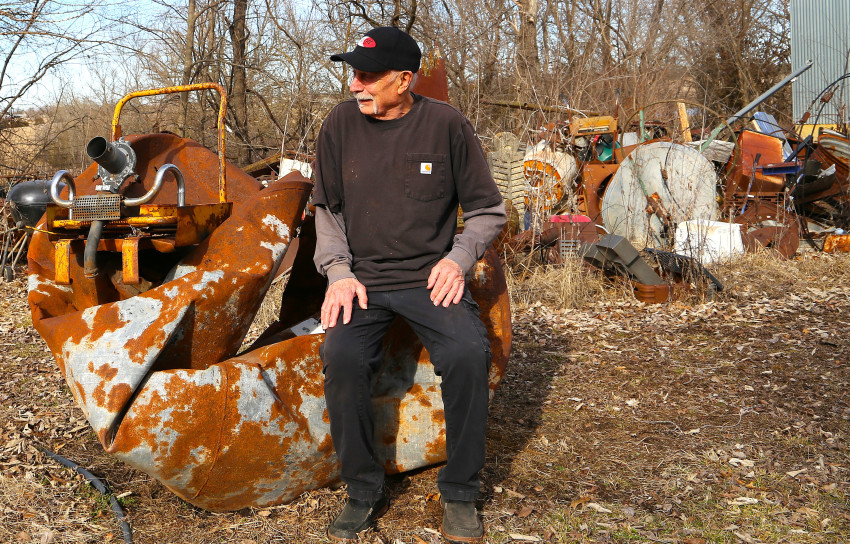 “I learned where the bad bulls and mean dogs were pretty quick,” he says. “Those were pretty good days because it was all discovery and exploration.”
“I learned where the bad bulls and mean dogs were pretty quick,” he says. “Those were pretty good days because it was all discovery and exploration.”
The freedom and creativity honed during childhood eventually led to a career in advertising, first as an art director and later a creative director.
“To combine both the writing and the art was unusual in the business, but it saved me a bunch of time and money when I had my own agency,” Wise says.
His first agency job was in Omaha, Neb., but he eventually moved to Los Angeles to write a book before picking up a job with an advertising agency there. Wise says he mainly kept to himself there, but it was still a “marvelous experience” working on ads for a major car company.
“In advertising you run up against problems almost daily,” Wise says. “It’s probably like working at a governmental agency where you have to please two or three different bureaus.”
It was a force of nature, not the bureaucracy that helped Wise decide to return to continue his advertising career in Kansas City. Wise was in his office early one morning when an earthquake shook the building. “I decided then to make my move.”
“I told them, ‘I’ve had a wonderful time here, but I’m leaving because of the earthquakes. I want to get back home where there are horses and coyotes.’”
DIFFERENT SET OF RULES
In creating art, Wise works under a different set of rules that he learned when attending the Kansas City Art Institute. He also attended Westminster College in Fulton, Mo., and the University of Arkansas.
“I experimented with collage a lot and fell in love with it,” he says. “Collage represented a whole different set of rules. I picked up things from the streets and trash bins and used them and they made some pretty striking statements.”
Wise’s collages are like piecing together a puzzle without a picture, but some sculptures carry more intention even if they’re not perfect anatomic representations.
“If I’m going to do a bird, I generally start out to do a bird,” he says. “It loosens up as you go. I never really know where that piece is going to end up.”
In contrast with his advertising work, Wise readily admits his style isn’t for everyone, noting those who “get it, get it.”
For a while he created life-sized sculptures of horses that drew a lot of interest from buyers.
“People kept wanting them and I had to keep making them,” he says. “It got to be like a job. It wasn’t fun art anymore. You have to compromise a lot. I’m not much of a compromiser.”
Wise says he made a pretty good income from his sculptures and collages through shows prior to the pandemic.
“Covid changed a lot of people’s lives, including mine,” Wise says. “I had a pretty good income from sculpture and that went away.”
PEN AND PAPER
Like his advertising career, Wise has continued to wield a pen, or at least a laptop, writing poetry, essays for literary journals and books. The paychecks aren’t very lucrative, but Wise is still driven to create.
“I write mainly for literary journals, and they simply don’t pay very much,” he says with a chuckle. “It kinda tarnishes the excitement of being published when you don’t get paid much. But what I write does get published.”
Wise says he’s written “six or eight” books, and a check of his website has 10, though two are in progress. Subjects are varied, with books of poetry like “The Taste of Red-Orange” and “Horses See Ghosts.” There are a couple volumes of short stories and a novel about the JFK assassination.
His most recent, “Chickens One Day, Feathers the Next,” is his first collection of nonfiction essays. Allegedly. In the author’s note, Wise paraphrases Jim Harrison in warning readers, “I’m not sure I’m equipped to tell the truth,” he writes, before promising the best version of his truth.
The book recounts several stories of a life well lived, though with some regrets. It’s humorous and raw and profane, but not needlessly so.
MIXED MEDIUMS
In some ways Wise never outgrew his childhood spent wandering, moving from city to city and agency to agency before settling in New Lancaster. He’s excelled at expressing himself through mixed mediums from sculpture and collage to poetry and fiction.
Despite his successful career in advertising, Wise is not a salesman of his own work. If you don’t get Wise’s artwork, it’s not for you. His writing is much more approachable, but for whatever reason it’s struggled to find a wider audience.
“I guess I write because I have to,” he explains in his book. “If it resonates with a public out there, fine. If it doesn’t, I’m not going to try and figure out what does.”
It takes some of the fun out of creating, but Wise’s best audience is still himself. If he likes the work, it’s good. There are similarities in his art and writing – being compelled or inspired to create. But they diverge in their origins.
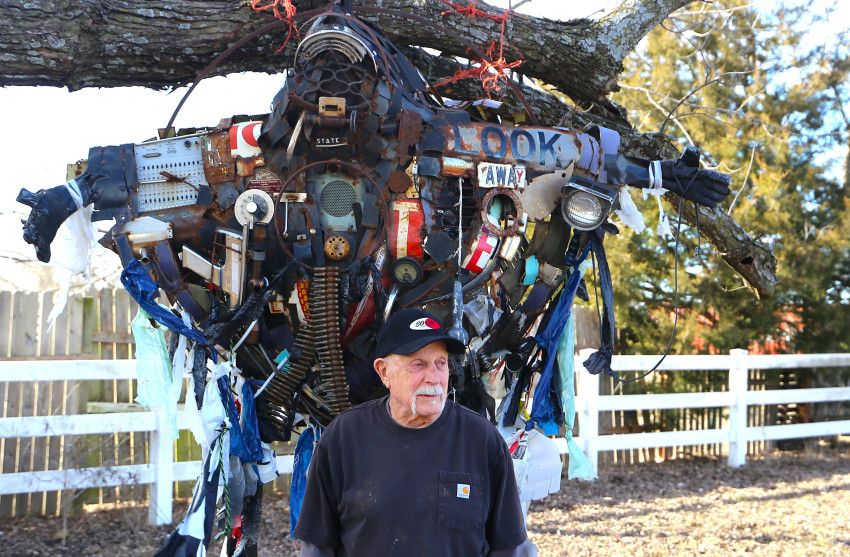 “They both have a narrative, but for art it seems to come from a different place,” he says.
“They both have a narrative, but for art it seems to come from a different place,” he says.
One gets the sense Wise still knows where to find the bad bulls and mean dogs. He’s still discovering, still exploring. Being a wanderer has its advantages.
Only now he doesn’t have to walk very far before a piece of junk catches his eye and inspires his next creation. Or, if not, he can just keep on walking.
Learn more about Guinotte Wise and his work at www.wisesculpture.com.



